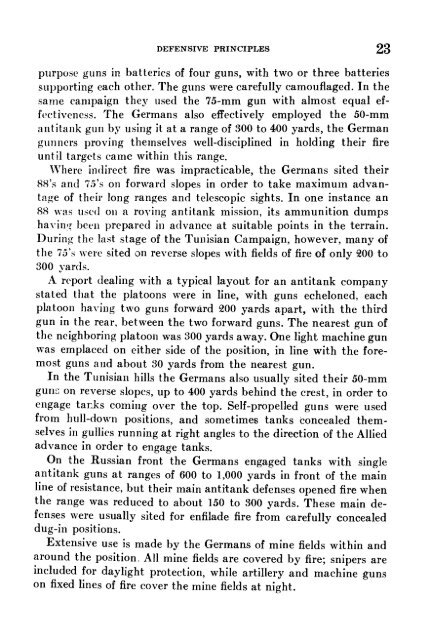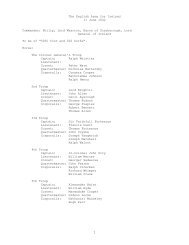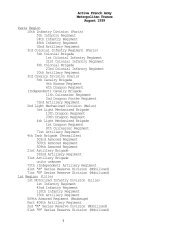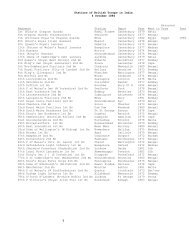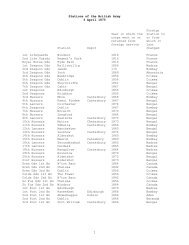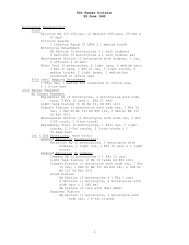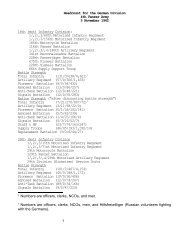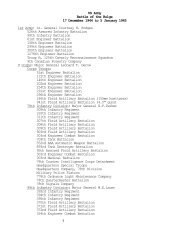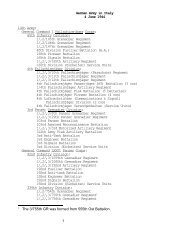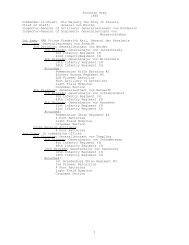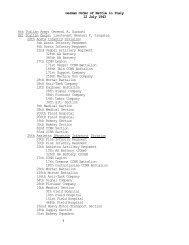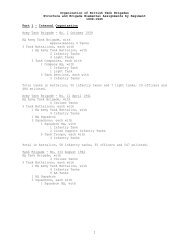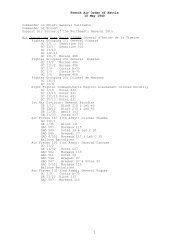Company Officer's Handbook Of The German Army - Command and ...
Company Officer's Handbook Of The German Army - Command and ...
Company Officer's Handbook Of The German Army - Command and ...
You also want an ePaper? Increase the reach of your titles
YUMPU automatically turns print PDFs into web optimized ePapers that Google loves.
DEFENSIVE PRINCIPLES 23<br />
purpose guns in batteries of four guns, with two or three batteries<br />
supporting each other. <strong>The</strong> guns were carefully camouflaged. In the<br />
same campaign they used the 75-mm gun with almost equal effectiveness.<br />
<strong>The</strong> <strong>German</strong>s also effectively employed the 50-mm<br />
antitank gun by using it at a range of 300 to 400 yards, the <strong>German</strong><br />
gunners proving themselves well-disciplined in holding their fire<br />
until targets came within this range.<br />
Where indirect fire was impracticable, the <strong>German</strong>s sited their<br />
88's <strong>and</strong> 7,5's on forward slopes in order to take maximum advantage<br />
of their long ranges <strong>and</strong> telescopic sights. In one instance an<br />
88 was used on a roving antitank mission, its ammunition dumps<br />
having been prepared in advance at suitable points in the terrain.<br />
During the last stage of the Tunisian Campaign, however, many of<br />
the 75's were sited on reverse slopes with fields of fire of only 200 to<br />
300 yards.<br />
A report dealing with a typical layout for an antitank company<br />
stated that the platoons were in line, with guns echeloned, each<br />
platoon having two guns forward 200 yards apart, with the third<br />
gun in the rear, between the two forward guns. <strong>The</strong> nearest gun of<br />
the neighboring platoon was 300 yards away. One light machine gun<br />
was emplaced on either side of the position, in line with the foremost<br />
guns <strong>and</strong> about 30 yards from the nearest gun.<br />
In the Tunisian hills the <strong>German</strong>s also usually sited their 50-mm<br />
guns on reverse slopes, up to 400 yards behind the crest, in order to<br />
engage tanks coming over the top. Self-propelled guns were used<br />
from hull-down positions, <strong>and</strong> sometimes tanks concealed themselves<br />
in gullies running at right angles to the direction of the Allied<br />
advance in order to engage tanks.<br />
On the Russian front the <strong>German</strong>s engaged tanks with single<br />
antitank guns at ranges of 600 to 1,000 yards in front of the main<br />
line of resistance, but their main antitank defenses opened fire when<br />
the range was reduced to about 150 to 300 yards. <strong>The</strong>se main defenses<br />
were usually sited for enfilade fire from carefully concealed<br />
dug-in positions.<br />
Extensive use is made by the <strong>German</strong>s of mine fields within <strong>and</strong><br />
around the position. All mine fields are covered by fire; snipers are<br />
included for daylight protection, while artillery <strong>and</strong> machine guns<br />
on fixed lines of fire cover the mine fields at night.


